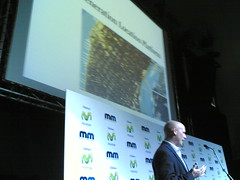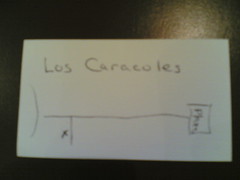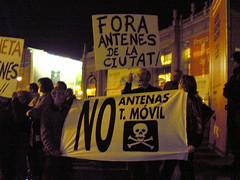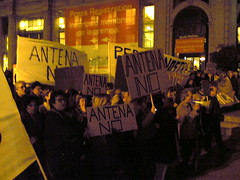Posted: February 27th, 2007 | 3 Comments »
The Amgen Tour of California took place this week. During this year’s edition, 7 riders have been tagged with CSC’s OmniLocation devices to send a constant stream of GPS data to the T-Mobile GSM network (over general packet radio service signals, HTTP streaming and SMS messaging). In consequence, The race’s web spectators had access to almost-real-time location information displayed on Yahoo! maps for the riders with a short delay offset (i.e. about 10 seconds).


Screenshots from the live webcast featuring the rider tracking system.
Relation to my thesis: Using sensors to track performances in sport is nothing new. Yet, this is an example of deployment in a semi-uncontrolled settings (the GSM network provider was a sponsor). Moreover, I am wondering about the web spectator’s experience in watching dots moving (without smooth animation but with icons of riders jumping from one location to another) on a map. Finally, the web application does not seem to take into account the delay offset from the acquisition of the location to the display on the screen. I suspect that a sharp synchronization of the geodata had to be performed prior to the visualization.
Posted: February 27th, 2007 | 1 Comment »
Artist Aram Bartholl has performed a couple of compeling locative media projects. In Plazemark he connects places painted with 2D-Codes with Plazes. Lately, he has been building and deploying physical dots of Google Maps (movie) and Plazes.


Relation to my thesis: we know how to augment the physical space with virtual information… what would happen if this virtual information could get fabjectized?
Posted: February 20th, 2007 | 1 Comment »
My paper (co-authored with Mike Blackstock and Nicolas Nova) for the workshop on Common Models and Patterns for Pervasive Computing (CMPPC) at the Pervasive 2007 conference has been accepted. All the accepted position papers are available online.
Issues from Deploying and Maintaining a Pervasive Game on Multiple Sites (pdf)
Abstract. In this paper we present the lessons learned from the deployment of a collaborative pervasive game on two different sites. We emphasize on the practical aspects of getting a pervasive systems deployed without any extra special infrastructure. Based on our experience, we describe the issues providers and administrators must take into consideration to deploy and maintain pervasive environments. In this perspective, we highlight that ubiquitous technologies must be consciously attended, as they are unevenly distributed, unevenly available.
Relation to my thesis: a paper I can link to whenever I mention the issues around deploying and maintaining CatchBob! Pervasive 2007 will take place on May 13-16 in Toronto, Ontario, Canada.
Posted: February 20th, 2007 | 1 Comment »
My paper for the CHI 2007 doctoral consortium has been accepted.
Bridging the social-technical gap in location-aware computing
Abstract. Building ubiquitous applications that exploit location requires integrating underlying infrastructure for linking sensors with high-level representation of the measure space to support human activities. However, the real-world constraints limit the efficiency of location technologies. The inherent spatial uncertainty embedded in mobile and location systems constantly challenges the coexistence of digital and physical spaces. Consequently, the technical mechanisms fail to match the highly flexible, nuanced, and contextual human spatial activities. These discrepancies generate a social-technical gap between what should be socially supported and what can be technically achieved. My research aims at exploring, and hopefully reducing this gap in the context of location-aware computing.
Relation to my thesis: “In total, we received 96 submissions and 15 were accepted to participate at the conference”. This is a clear sign that the definition and expression of my ideas have matured. CHI 2007 will take place in San Jose, CA between April 28 and May 3.
Posted: February 18th, 2007 | No Comments »
Davies, N., Landay, J., Hudson, S., and Schmidt, A. Guest editors’ introduction: Rapid prototyping for ubiquitous computing. Pervasive Computing, IEEE 4, 4 (Oct.-Dec. 2005), 15– 17.
The authors suggest that, as in earlier HCI efforts, the progress in prototyping methods and tools is central overcome the barriers to widespread development and deployment of ubicomp. Rapid prototyping techniques can partially solve the current dilemma of researchers and developers who must concentrate on their specific area to advance technology rather than expend effort on broad system-implementation issues. Low-fidelity prototyping can adapt to the pervasive computing requirements and proves to be an essential means to address the questions about user performance and user acceptance.
This paper serves as introduction to Prototypes in the Wild: Lessons from Three Ubicomp Systems.
Relation to my thesis: A useful ref for my “in sitiu” approach of location-aware system evaluation. Actually, the authors describe it as:
Research shows that prototyping and deploying systems for study is important to understanding how systems fit into the user’s world and how they can be used effectively. Designing, building, and deploying systems help both researchers and developers better understand a particular application domain’s key issues. This issue provides a rich body of experience in issues associated with prototype deployment.
Posted: February 17th, 2007 | No Comments »
I got mostly aware of persuasive computing during last year’s ubicomp conference, and Yvonne Rodger’s paper Moving on from Weiser’s Vision of Calm Computing: Engaging UbiComp Experiences. Persuasive computing, in reaction to calm computing, aims at using technologies that motivate, facilitate and trigger changes in behavior and attitudes. The trend I believe mainly comes from the US due to the country’s weight and health problems.
One example is Julian Bleecker’s Flavonoid that transact actions and activities between the physical worlds and digital online worlds. Flavonoid is envisioned as a platform for a variety of embodiments. In one embodiment of the project concept, data feeds produced from the Flavonoid Kinesthometer is used to “bulk up” or “fatten up” its owner digital photograph on a social networking site, depending on whether he/she has been actively moving or sedentary in 1st Life. In another embodiment of the project concept, data feeds from the Flavonoid Kinesthometer slows one’s online character down in 2nd Life for lack of energy based on sedentary 1st Life behavior.
Early this month, the Stanford Persuasive Technology Lab (BJ Fogg, Dean Eackles) hosted the Mobile Persuasion 2007 conference. Joe McCarthy posted a summarized version of his 12 pages notes: Mobile Persuasion 2007: Triggering Changes in Attitudes and Behavior. From what I can read, the main use of technology to change people’s beliefs and behaviors are to: make the invisible visible, raise awareness of [bad] habits in communication, transportation (environmental issue), exercise (activity-induced energy expenditure (AEE) over the body mass index (BMI)) and diet, (persuasive) gaming.
Prior to CHI, the Stanford Persuasive Technology Lab will be hosting the Persuasive 07 conference.
Relation to my thesis: Same as for an calm vision of ubicomp, technology cannot persuade anyone who doesn’t already want to be want to be persuaded. The frontier between engagement and persuasiveness is still unclear to me. My recent posts on the new agendas of ubicomp can strengthen the introduction in my thesis.
Posted: February 16th, 2007 | No Comments »
At the end of his talk on Big Games: Large-Scale, Multi-Player, Real-World Games at Where 2.0 in 2005 (audio), Kevin Slavin came up some “chili computing” (coined by Frédéric Kaplan at Lift) concepts around the experience of location in real-world games. First he mentioned that location is more than GIS data. Location has a wider context and different meanings, it is about being indoors, outdoors, about hearing the busy sound of a street or not. Then he suggest that in fact disinformation and “dislocation” might be more engaging to people as we might become interested into getting lost and making things up (aiming at misrepresentation rather than accuracy). This idea of inventing the real reminds me a discussion with Julian on his current game ideas around the concept of familiar strangers and his inspiring talk When 1st Life Meets 2nd Life.
Relation to my thesis: While my specific work aims at the opposite of using technologies to get lost and tell use lies, I find the approach very relevant. The approach actually reveals that “constraints aren’t what break games. Constraints are what makes them work”. It can be an inspiration for designer of location-aware systems who must deal with quality and accuracy issues could. Instead of hiding the problems or aiming at sharp accuracy, an application might be more engaging when it is less “serious”. This relates to my last week’s discussionwith Frédéric on the nabaztag who tells the weather. Because, the nabaztag is not serious by itself, it is okay if he makes mistakes on forecasting the weather. Actually, its mistakes might lead into a discussion and a collaborative correction of the error.
Posted: February 16th, 2007 | No Comments »
Skyhook Wireless announced at 3GSM the collaboration with SiRF to create a single positioning system that combines the best of both GPS and Wi-Fi technologies. I could also get a glimpse in the upcoming Skyhook-enabled iRiver W10.

Jed Rice, Skyhook Wireless, at the Mobile Monday Global Peer Awards.
Relation to my thesis: Location sensor fusion is now happening in the industry. In the context of my research, the limitation of this approach is still at a network level to communicate the sensed position. While WiFi access points can be used for triangulation, an open access cannot be legally used to exchange data. In consequence, collaborative (and synchronous) location-aware application must uniquely rely on GSM.
At the Mobile Monday Global Peer Awards, Jed Rice announced that Skyhook had “scanned” Barcelona over the last past weeks. This is certainly an opportunities to play around with their APIs and prototype my upcoming experiments. Skyhook nurtures tight relations with the academic world and have been involved in facilitating pervasive and big games in partnership with Kevin Slavin and Frank Lantz’s company area/code. The same Keven Slavin who teaches urban computing at NYU with Adam Greenfield. Small world.
I love the happy contradictions of 3GSM. Ironically, once again this year, it was almost impossible to get decent WiFi connexion. I was also presented a path description to a restaurant drawn on by an LBS specialist on the back of his business card:

Posted: February 15th, 2007 | 1 Comment »
Last week, I participated to a workshop on The City of the Future organized by Nicolas Nova (EPFL) and William Cockayne (Stanford). More than brainstorming about, it was the opportunity to learn about critical foresight methodology and techniques. Both Mauro and Nicolas wrote a very complete report on the petal graph, the S-curve, cartesian diagram and the diachronic table.
Relation to my thesis: ubicomp is also about projecting how sensor, wireless and distributed technologies will be used and integrated in the future. In foresight much can be learned by looking at the past and comparing it with the present. Now that we have the first glimpse of real-world ubicomp environments (as mentioned by Adam Greefield, Bell and Dourish) we can reflect on Mark Weiser’s visions of calm computing and the dissapearing computer. Based on how we got here, we can start building alternative agendas such as the new approaches suggested by Yvonne Rodgers. During the workshop we watched Walt Disney’s visions for the city of EPCOT in the 60s to reflect on our own visions of the future of the city (e.g. where was Walt wrong or correct and what path lead to his visions).
Posted: February 14th, 2007 | No Comments »


A protest in front of the 3GSM Congress in Barcelona last night. I like the “Keep the antennas out of the city!” not-in-my-backyard kind of sign as well as, on the side, a placard referring to the bible.
Reuters (blog) reports:
Demonstrators in Barcelona rallied against cell towers and radiation outside the fenced-off 3GSM, the world’s largest wireless trade show. About 100 protesters carried placards and chanted: “Don’t just talk business, talk about health as well.” Where are the tin-foil hats when you need them?
Relation to my thesis: constraints to innovation and “progress”.









